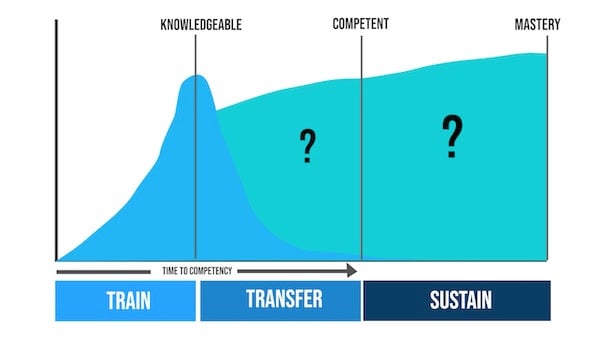What is Continuous Learning in the Workplace? Why is it Important?
Maybe you are like me. You went to college, got a degree, and then you expected to know everything there was about your career.
But, if you’re like me, you realized early on in your first post-grad job that you didn’t know everything (or nearly enough). So you spent time googling terms you don’t know or “how to write a fill-in-the-blank proposal.”
The same thing happens for employees in your organization. After your onboarding classes, they need other resources to fill the knowledge gaps. Instead of turning to Google to expand their knowledge, you can provide them with the support they need.
When you use continuous learning as part of your training strategy, you provide employees with the expanded training (general and specific to your company) opportunities to help them grow and improve in their roles.
Working for ScreenSteps — a knowledge base software company that enables employees to learn faster in the workflow — I’ve seen how providing documented help guides saves time training and supports employees on the job.
If you’re interested in helping your employees learn and develop beyond classroom training, then continuous learning can help. Below, I explain what continuous learning is, its benefits, and what you need to get started with it.
What is continuous learning?
Continuous learning is a training development concept that provides opportunities for employees to learn while they are doing their work. It is an education in the workplace that happens after the initial onboarding.
With continuous learning, you are providing resources and learning opportunities that go beyond the classroom. Your employees develop skills, knowledge, and advanced abilities while working.
It expands on your initial instructions so that your employees can continue to build on their knowledge and become experts in their fields.
Classroom training vs. continuous learning
While a continuous learning plan can include classroom training — such as lunch and learn sessions — continuous learning is focused on a variety of training moments. This includes workflow learning opportunities.
If you look at the Train, Transfer, Sustain Model, which was developed by Conrad Gottfredson and Bob Mosher, classroom learning and continuous learning handle different aspects of training. In each phase of the model, employees fulfill a different part of the learning process.
- Train - Employees learn new skills, including how to use software and about company strategies.
- Transfer - Employees apply what they learned in training, which includes reviewing resources to compensate for information they forgot.
- Sustain - Employees build on what they learned in training and adapt to change.

🔍 Watch Related: How Does ScreenSteps Fit in with Your L&D Technology and Strategy? [VIDEO]
Classroom training
Classroom training addresses the “Train” section of the Train, Transfer, Sustain Model. Employees are learning information, skills, software, etc. that they didn’t know before training began.
Continuous learning
Continuous learning, on the other hand, is meant to help through that “Transfer” and “Sustain” phase of learning. Using continuous learning materials, you can cut down the amount of time the “Transfer” stage takes.
In the “Transfer” phase, employees take what they learn in the classroom and apply it on the job. However, employees can’t remember everything they learned in the classroom. That’s where continuous learning resources come in. It serves as a reminder of what they learned until they are competent enough to do it on their own.
During “Sustain,” continuous learning helps teach employees advanced skills and how to handle updates to your companies policies, processes, and procedures.
Examples of continuous learning
There are a variety of ways to include continuous learning as part of your training strategy. Some examples of continuous learning include:
- e-Learning courses
- Lunch and learn sessions
- Help guides (ie: step-by-step guides for your policies and procedures)
- PDFs
- Charts
- Workshops and conferences
- Coaching and mentoring
- Book clubs
What are the benefits of continuous learning?
Providing continuous learning opportunities benefits both your company and your individual employees.
3 benefits for the company
There are many benefits to including continuous learning as part of your training strategy. Here are three ways using continuous learning benefits your business.
1. Engaged employees
When your employees are engaged in the learning process, you are able to optimize your employees’ work. Employees feel valued when you are willing to invest in them.
Knowledge is power. As employees participate in continuous learning, they will become more experienced and knowledgeable. Consequently, this will increase productivity and the quality of their work.
2. Less time in classroom training
Classroom training can take up to months to complete. That’s because companies feel employees need to know EVERYTHING about how to do their job before they even try a task.
With continuous learning, you can use materials (ie. help guides, PDFs, etc.) to assist employees while they are in the workflow. Taking this approach, your new hires will spend less time in classroom training and become proficient at their jobs faster.
Note: If you use a cloud-based system to share your documents — like a knowledge base or document library — it makes it easier to share updated instructions with your team. This makes it easier for your employees to adapt in the long run.
3. Cost savings
Investing in your employees’ development is less expensive than the costs of replacing employees that leave your company. It is both time-consuming and expensive to recruit, hire, and train new employees.
3 benefits for the employees
Through continuous learning, employees experience personal enrichment in their careers with your company. Here are just three of the many individual benefits employees receive from continuous learning:
1. Career development
Employees can advance their skillset as part of their job. They can learn marketable skills and, as they master those skills, they can build on those skills. This helps expand their knowledge and gives employees a sense of accomplishment.
2. Confidence on the job
For employees, it is intimidating to go through classroom training and then be expected to know how to do their job. The reality is that new hires will forget information from onboarding.
When you have continuous learning materials, your employees don’t need to worry about forgetting information. Employees don’t need to fear failure.
They will have helpful resources and reference materials to expand their knowledge and support them on the job. This makes employees feel more comfortable and confident that they can complete their tasks.
3. Prepares employees for promotion
As employees gain more skills and knowledge, they are going to be better prepared to take on more responsibilities. Having continuous learning prepares them for promotion and future roles they might have with your company.
This is also a benefit for your company since you will always have a pipeline of internal employees to promote to higher positions.
What do you need for continuous learning?
To implement continuous learning in your business, you need certain elements to ensure adoption and success. Here are three key elements you need to incorporate continuous learning in your company.
1. Learning strategy
Before you add a new training element to your company, you’ll want to zoom out and look at the big picture. How does continuous learning fit in with your overall training strategy? You’ll want to define your purpose for adding continuous learning.
Above I listed a variety of ways to incorporate continuous learning in your business. Which aspects of continuous learning do you want to use? Understand the costs and work involved with adding these different continuous learning options.
2. Procedures that “stand on their own”
In order to create continuous learning materials, you will need to standardize your policies, processes, and procedures.
These documented instructions need to be able to “stand on their own” — meaning employees can use them without needing to ask someone clarifying questions. Procedures that stand on their own:
- Are formatted to allow for increasing levels of detail, starting with just the essentials, but then expanding to full explanations
- Help employees navigate complex decisions
- Are easy to find in your system
- Allow employees to provide feedback so that the process can stay current and improve
🔍 Related: How Long Should My Written Company Procedures Be?
3. Software and technology
Depending on the type of continuous learning options you decide to use, you may need additional software and technology. Some options to consider include:
- Knowledge base software
- Cloud-based document library
- Learning management system (LMS)
- Employee enablement system
Ready to include continuous learning in your training strategy?
There are many options available for incorporating continuous learning in your workplace. It’s important to choose a strategy that fills in the knowledge and skills gaps in your company.
With a ScreenSteps knowledge base, you can create help guides faster that will help your employees learn while in the workflow. These guides support employees so they are making fewer mistakes, are less stressed, and are better able to adapt to change.
Are you considering using help guides, documented procedures, or courses as part of your continuous learning strategy? Or maybe you are considering including self-paced courses?
If that is the case, you’ll want to consider getting a knowledge base or LMS to support your continuous learning goals. Learn more about the roles and differences of a knowledge base and LMS in the article below.




